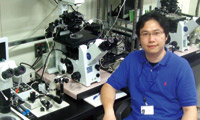Aug. 11, 2011
Breeding rewards in mouse cloning research
Chong Li, Research Scientist

Laboratory for Genomic Reprogramming, RIKEN Center for Developmental Biology
What do you do at RIKEN?
I am a postdoctoral researcher working on genomic reprogramming at the RIKEN Center for Developmental Biology (CDB). My main task is to develop novel methods in germ cell preservation and somatic cell nuclear transfer.
How and when did you join RIKEN?
I joined RIKEN in 2007 while studying for my PhD at Kwansei Gakuin University in Hyogo, Japan. It had always been my dream to work at RIKEN because of its strong research prowess in many scientific fields. When I contacted my current team leader, Teruhiko Wakayama, who was an affiliate professor at my university, he fortunately agreed to allow me to become a member of his group.
What attracted you to RIKEN?
The two times that I visited RIKEN during my master’s course, it left a very strong impression on me of being a great research institute. There are so many top-notch research groups covering a variety of fields, and researchers are able to share cutting-edge equipment to conduct their experiments—something that would not be possible at a university. RIKEN provides researchers with a strong support network for research, such as good support for the laboratories. This allows me to confidently carry out creative research here.
How was the transition to life at RIKEN?
My transition to RIKEN was smooth because I had lived in Japan for three years prior to joining. The Chinese and Japanese cultures are also similar. I love being at RIKEN. At my laboratory we usually have lunch together and talk about Japanese and international current affairs. My colleagues are like a big, welcoming family—I often forget that I am a foreigner.
Please tell us about your research or other work at RIKEN.
My research is divided into two parts. One of these parts is focused on improving the cloning efficiency of mice. The first mouse was cloned by our team leader Dr Wakayama in 1998, but the low offspring rate is still a big limitation for the technology. We are trying to address this using such agents as histone deacetylase inhibitor or DNA methyltransferase inhibitor to increase the full-term development of cloned mice. The other part of my research involves investigating ways to preserve germ cells, or spermatozoa, over long time periods without freezing them. Most germ cell preservation methods require liquid nitrogen, which poses safety problems during the transportation stage. I preserve germ cells in a single medium with an additional protectant to ascertain the storage limitation at a refrigerator temperature.
What have been the highlights of your time at RIKEN so far?
There have been countless memorable moments so far. For example, I will never forget the birth of my first cloned mouse or the first time one of my papers was accepted for publication. The time I won an award at an international conference for the first time was also very memorable.
What has been the best thing about working at RIKEN?
RIKEN is not only a great research institute, it also provides opportunities to study while conducting research. The CDB holds symposia and lunch forums every week at which members from other groups as well as overseas scientists give presentations in their respective fields. Finding out about different fields is a great learning experience that allows me to broaden my horizons for future research.
What would you say to other people considering joining RIKEN?
RIKEN is an international institute for everyone who wants to do great research. Working at RIKEN is an invaluable experience in a researcher’s career.
